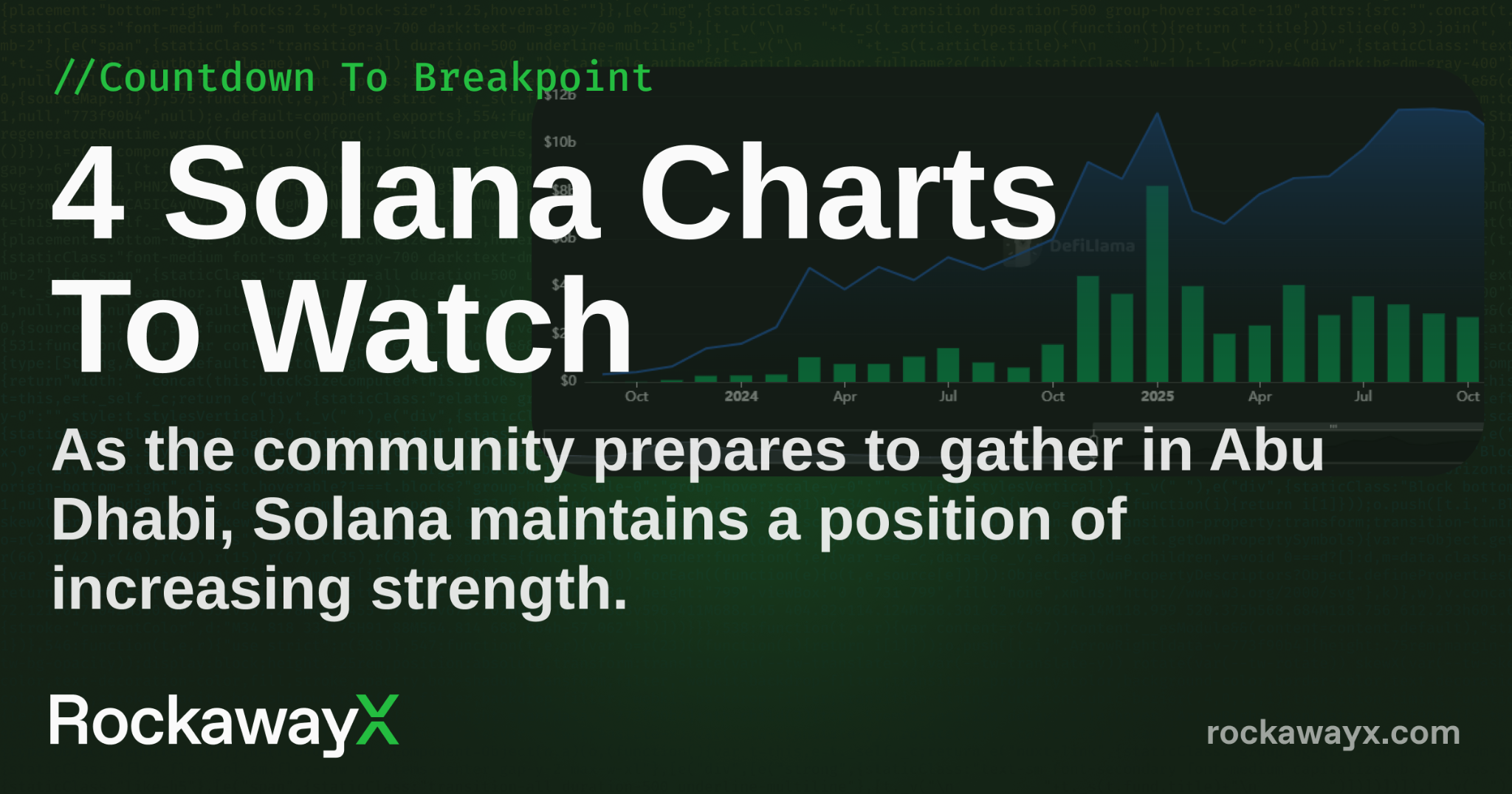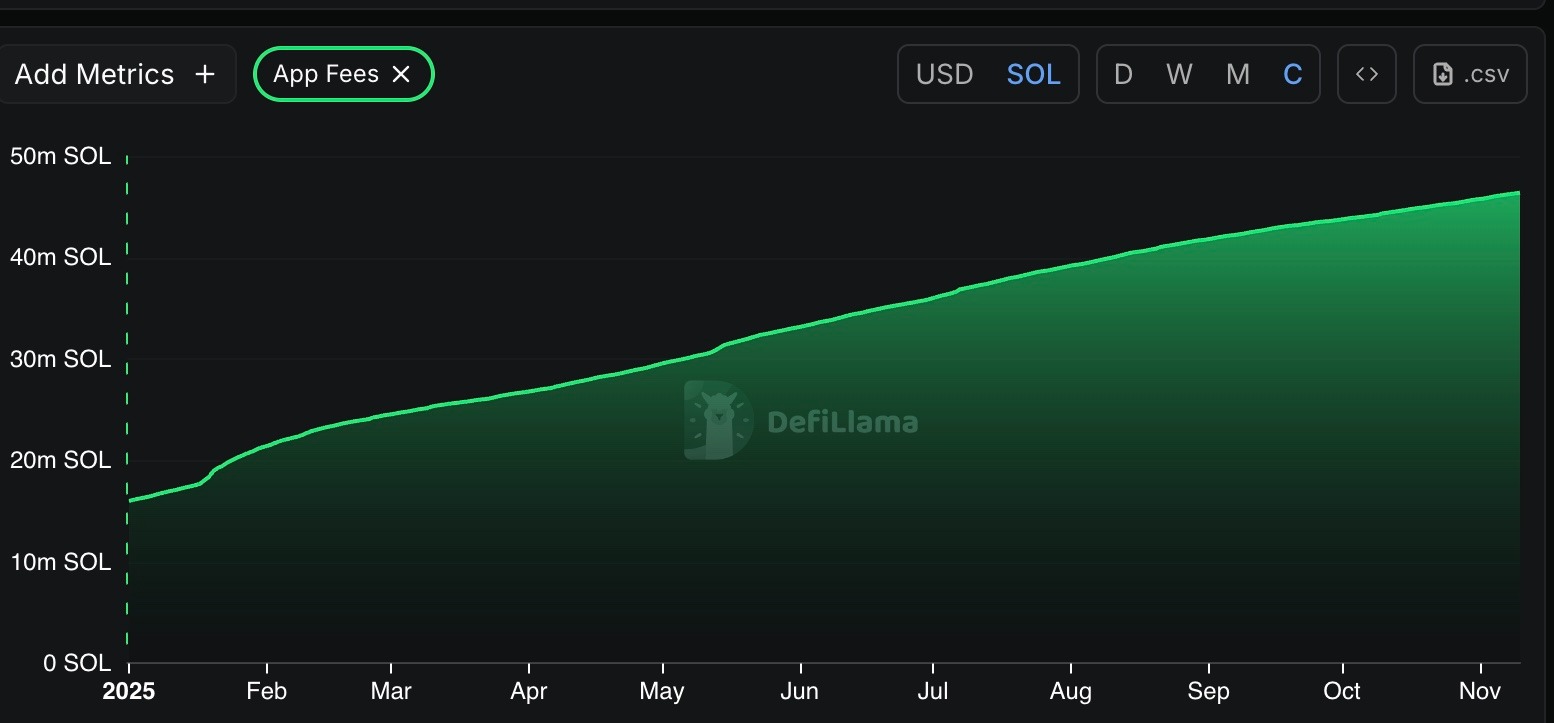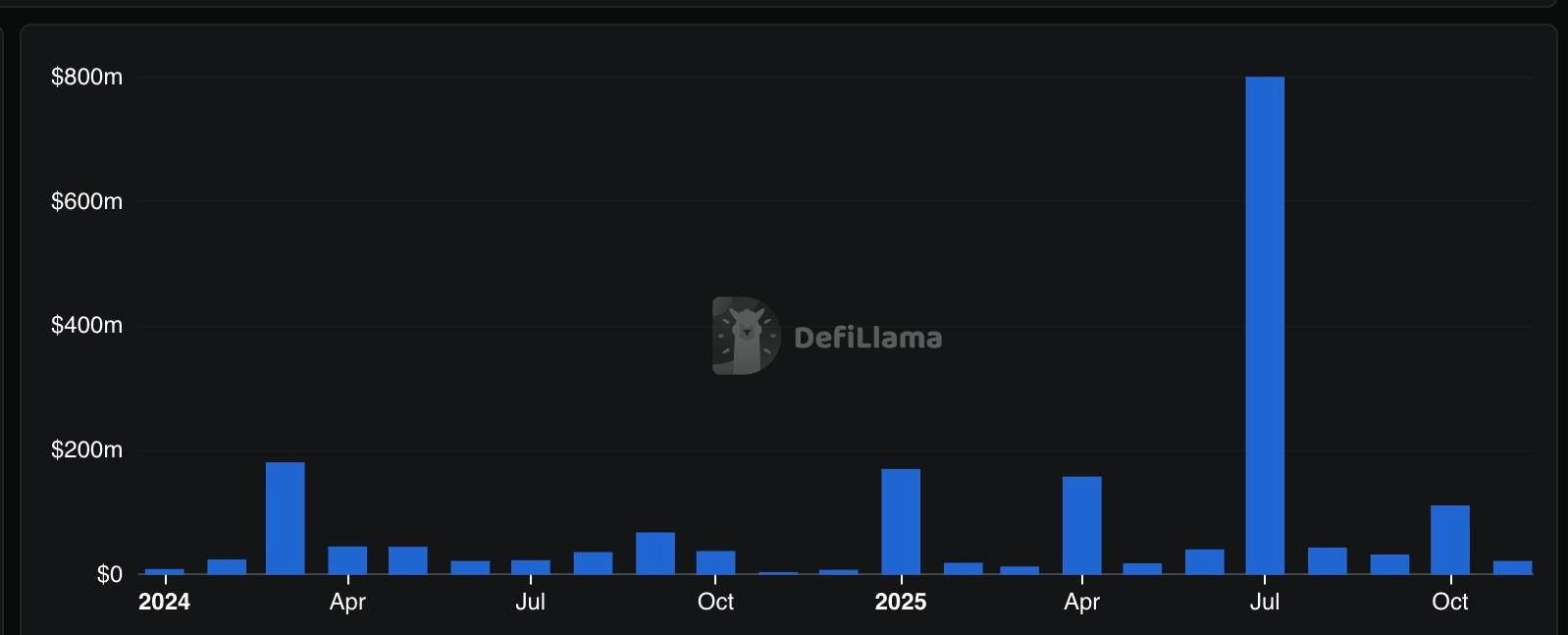
Last week, we started the countdown to Solana Breakpoint 2025 with an overview of five key developments defining the ecosystem this year.
Now, four weeks out, we’re turning to some more concrete data.
The network’s progress this year has been visible across every meaningful metric, from developer output to user participation and app revenue. So, to mark four weeks to Breakpoint, we’re highlighting four charts that you should be watching as we head into 2026.
DEX Volumes: Solana Leads Ethereum In Onchain Trading

DEX trading has been one of the key industry battlegrounds this year, with substantial mindshare and capital flowing to Hyperliquid and Aster. With trading being one of crypto’s most proven use cases, excelling in this category is essential for Solana to remain competitive.
Meanwhile, we’ve seen a key race playing out among Layer 1s, especially Ethereum and Solana, to win Wall Street’s attention as the base layer for tokenized markets. Tokenization has shifted from narrative to reality, with over $35 billion in assets now represented onchain and forecasts in the tens of trillions. For institutions, the real question is no longer if assets move on-chain but which chain becomes the default venue. Solana’s speed and cost profile give it a credible claim on that role.
As institutions explore tokenized markets, a similar shift is unfolding among traders, who have been moving to DEXs (primarily Hyperliquid and Aster), where the performance gap with centralized venues continues to narrow. The change has been driven by tighter spreads, deeper liquidity, and growing evidence that onchain trading is now capable of matching centralized venues in execution speed and consistency.
In the midst of this adjustment, Solana briefly fell out of focus; however, the tide is starting to turn in Solana’s favor. Recent data shows Solana’s DEX ecosystem frequently surpassing Ethereum’s activity, recording over $350 billion in trading volume over the past quarter and pushing cumulative totals above $2 trillion.
.png)
This traction is also evident in the yearly trading data. So far in 2025, Solana has processed roughly $1.36 trillion in DEX volume, comfortably ahead of Ethereum’s $900 billion. Building on that momentum, the same teams driving Solana’s resurgence are now showing measurable results onchain. Among them is Meteora, recording over $80 billion in DEX volume these past three months. Alongside Meteora, HumidiFi has been peaking near $40 billion in DEX volume for the month of October, channeling retail and meme-driven activity into sustained onchain volume. Raydium and Orca remain foundational as well, each generating over $20 billion in monthly trading volume in October.
Beneath the activity on the surface, Solana’s infrastructure layer has also seen improvement. Jito continues to optimize blockspace and MEV capture, while Ranger now routes orders to external venues like Hyperliquid without having to force users to bridge assets off Solana.
App Fees And User Engagement

Solana's application-level fees have continued to rise through 2025. This trend is a sign that users are engaged and that developers are creating compelling enough products/services to keep them on the chain.
What stands out most in this cycle is the variety of the projects now contributing to that growth. Rather than a handful of legacy platforms driving most activity, Solana’s fee base has diversified across a new generation of builders. Protocols such as Meteora and Pump.Fun remain among the most consistent revenue producers on the network. Meteora has led with over $1.16 billion in cumulative fees this year, with Pump.Fun following closely with $805.5 million. Also, this year, Jupiter has generated roughly $1 billion in cumulative fees, with over $100 million added in the past month alone.
A newcomer to the high rankings of fees, ORE has recently become one of Solana’s most fascinating success stories. The team took what started as a fair-mining experiment years ago and rebuilt it into an optimal system for value capture. Its new model turns mining into an onchain revenue engine: every round pulls in SOL, uses it to buy and burn ORE, and pays a portion back to stakers. The more people play, the more value cycles through the system, which creates deflationary pressure and keeps rewards tied to real activity. It’s a smart redesign that’s already paying off, pushing ORE into the top tier of fee-generating apps with almost $4 million just this past week. It’s proof that on any given week, if a team puts together a compelling experience paired with an optimal revenue model, noteworthy success can quickly be achieved.
The main takeaway from these examples is that Solana’s economy is usage-driven. Real apps are earning real revenue from real users, and the trend is continuing up and to the right. By building on Solana, developers gain access to an engaged, passionate audience. For users, being on Solana means that their favorite applications are more likely to generate revenue and will stick around in the long term.
Liquidity And DeFi Expansion: A Broader Base Of Onchain Capital

Solana’s DeFi landscape has undergone a visible expansion throughout 2025, with total value locked (TVL) rising from $8.53 billion in January to ~$10.4 billion by November. The expansion we’ve seen over the course of the year has been largely propelled by the leading protocols.
Kamino - Kamino is Solana’s go-to platform for onchain lending and borrowing. Between its automated vaults and all the benefits provided by Kamino 2.0, the protocol has been on an absolute tear this year. Its TVL has climbed from roughly $225 million at the start of 2024 to nearly $2.8 billion by late 2025, a rise that has solidified its role as one of Solana’s defining DeFi protocols.
Jito - Jito has seen its TVL climb from around $648 million in early 2024 to more than $2.3 billion today, driven by growing adoption of its validator-focused infrastructure and liquid staking products. Through its use of MEV tools and the new DoubleZero integration, Jito has had tremendous success in linking validator performance directly to onchain yield, helping strengthen Solana’s base layer while deepening liquidity across DeFi.
Sanctum - Since the start of the year, Sanctum’s TVL has grown from roughly $1.4 billion to just over $2 billion, showing how liquid staking is becoming a deeper part of the Solana ecosystem. Recent developments, including its partnership with Nansen to launch the nxSOL token and a collaboration with Bulk to introduce BulkSOL in October, highlight how Sanctum is shaping the next phase of Solana’s staking landscape. By maintaining a unified liquidity layer, Sanctum turns staked SOL into actively deployed, yield-generating capital that strengthens Solana’s DeFi economy.
Orca - In less than two years, Orca’s TVL has nearly doubled from $184 million to $386 million, proving its steady user demand even as competition increases. In recent months, the team introduced several initiatives that were focused on long-term sustainability. Notably, the inclusion of a $9.9 million treasury program for buybacks and validator staking, as well as the launch of Wavebreak, a human-first token launchpad designed to reduce bot activity. Through these initiatives, Orca remains one of Solana’s most dependable venues for simple token swaps and liquidity.
As Breakpoint and 2026 approach, we see Solana’s DeFi explosion continuing. New onchain yield primitives like OnRe are offering unique yield opportunities that can’t be found elsewhere. Core TradFi sectors like fixed income and real estate are growing through stellar projects like Exponent Finance and Parcl, respectively. And ETFs, DATs, and other large capital allocators holding SOL in their treasuries are keen to expand their yield profile by interacting with onchain protocols.
Solana Ventures And Ecosystem Investment

Investment trends often trail network momentum, and 2025 has been no exception. As Solana’s technical and user metrics strengthened throughout the year, venture activity around the ecosystem began to rise again.
So far, Solana-linked projects have raised roughly $1.428 billion, up significantly from about $503.07 million for the same period in 2024. The renewed pace of funding indicates that investors are backing Solana’s builders with growing confidence in the network’s strengths and growth prospects.
For Solana, the past four months have been particularly successful, with funding reaching 987.41M, ahead of every major blockchain. Ethereum, by comparison, garnered 456.41 M.
We’ve seen that funding has become more deliberate, directed toward projects with clear technical value and proven traction rather than short-lived hype. Above all else, investors today are emphasizing product reliability, active user bases, and technologies that strengthen the network as a whole. Ultimately, that change translates into initiatives that are more strongly aligned with the long-term prospects of Solana.
The Road to Abu Dhabi
Solana enters Breakpoint 2025 from a position of undeniable strength. Every major indicator, from developer activity and user engagement to onchain revenue and ecosystem investment, points toward a network that is expanding faster and more sustainably than ever before.
As the community prepares to gather in Abu Dhabi, Solana’s foundations are stronger than ever, and its trajectory into 2026 is set firmly upward.